Renewable Energy Project Where the Future Meets the Frontier Department of Public Works ENGINEER ING D EPARTME NT (541) 447-2357 (541) 447-5628 E M AI L eklann@cityofprineville.com PHO N E FA X
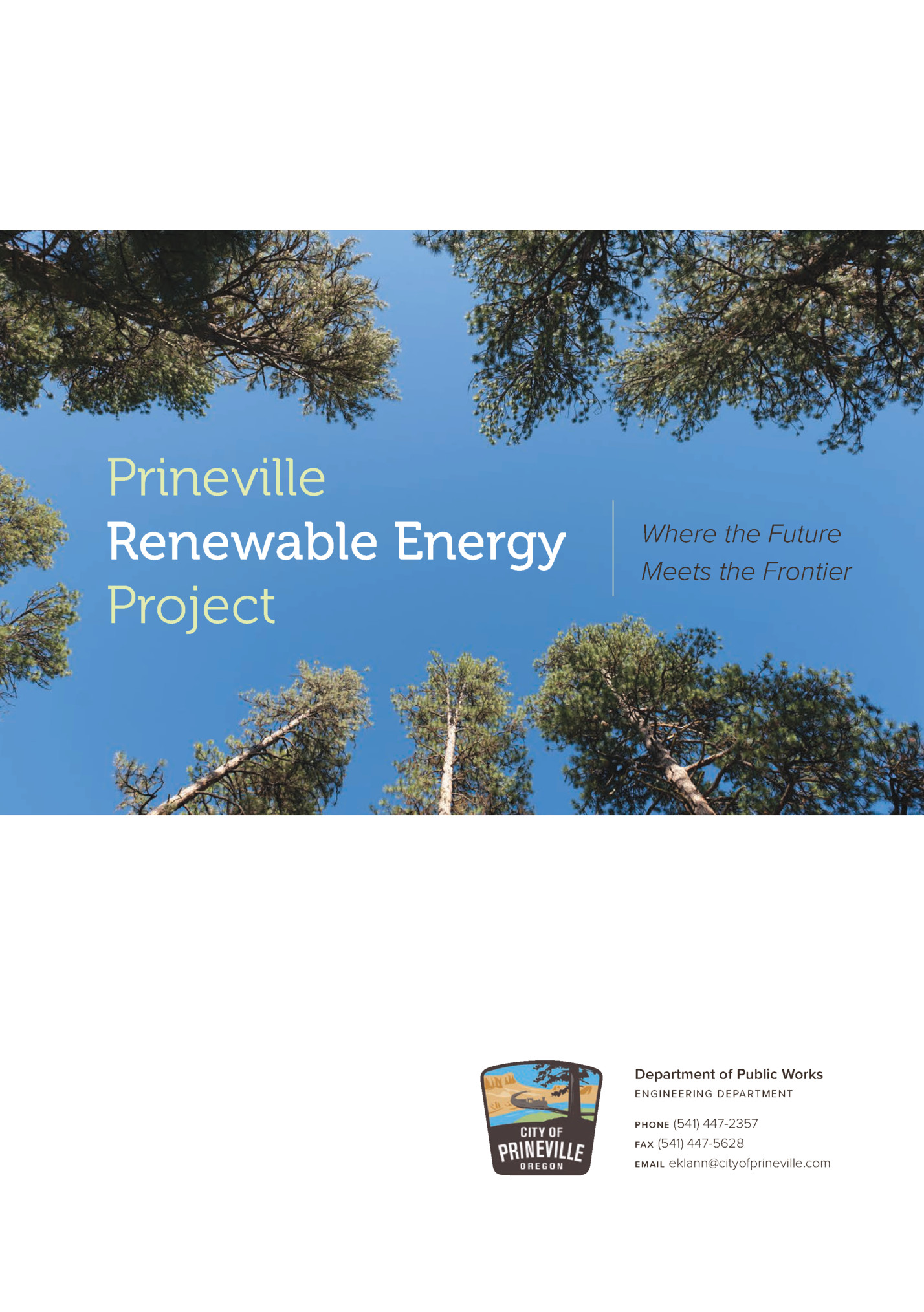
15 permanent, full time, living wage jobs and indirectly create another 100 jobs¹¹. In addition, over 200 jobs will be created over the course of construction. S H A N E J E F F R I E S Ochoco National Forest Supervisor The re-invented forest products industry will provide additional jobs for Prineville.
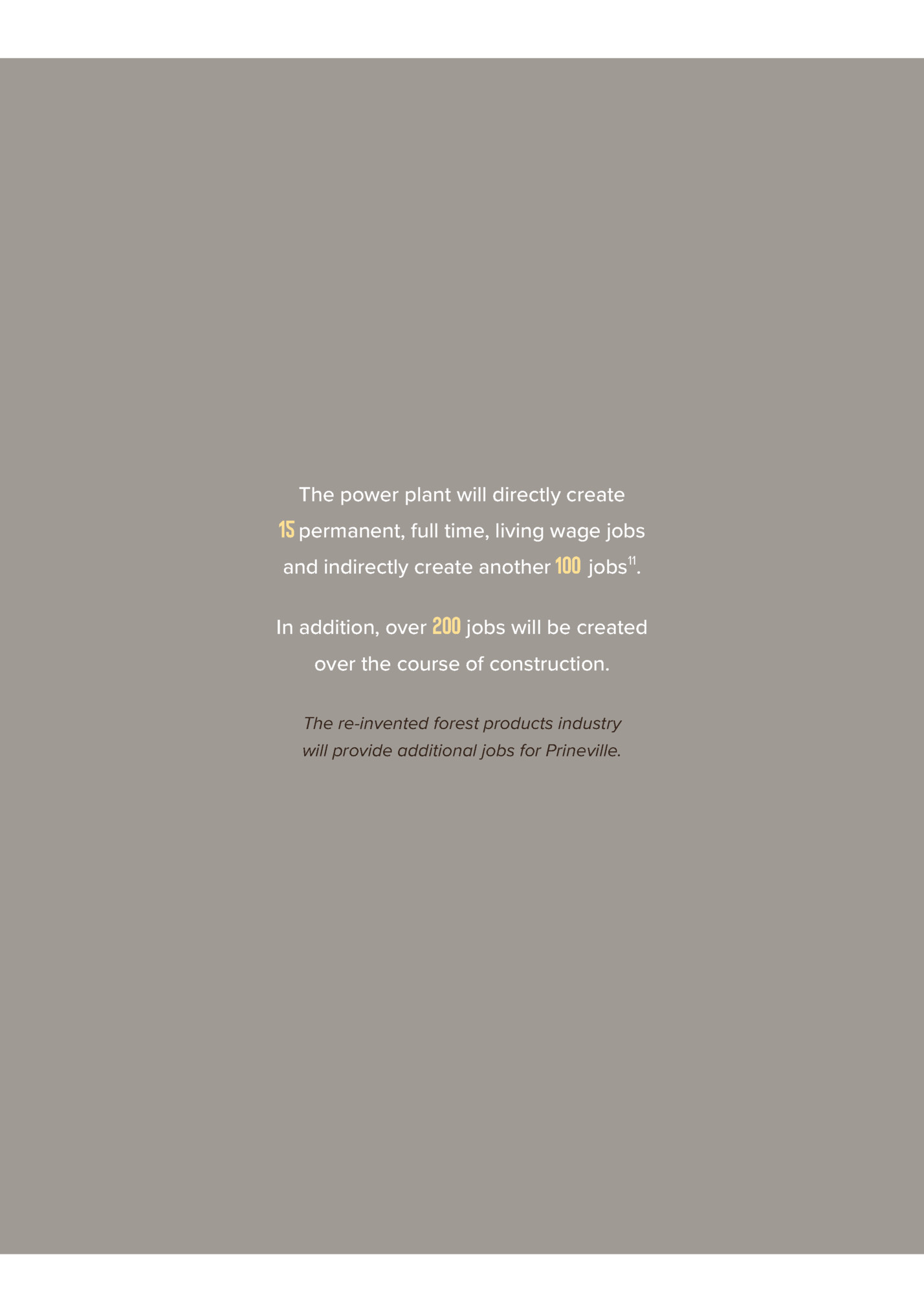
The City of Prineville has gained recognition as a national leader in its innovative approach to environmental protection and conservation with a reputation for its forward-thinking solutions. This is evidenced by multiple environmentally beneficial, cost effective, and award-winning projects such as The Crooked River Wetlands and Aquifer Storage and Recovery (ASR) project. Crooked River Wetlands: Provided a solution to the need for additional wastewater treatment and saved over $50 million by utilizing an integrated approach to wastewater treatment through beneficial reuse combined with the creation and restoration of wetlands, floodplains, riparian areas, and public recreation. Aquifer Storage and Recovery (ASR) Project: Water is collected in existing aquifers (natural geologic formations underground) during periods of cooler temperatures, higher streamflow, and lower demands and recovered later during periods of higher demand. City and County leaders are committed to creating long-term solutions that balance the needs of a healthy environment while ensuring a sustainable energy solution that meets growing community demands.
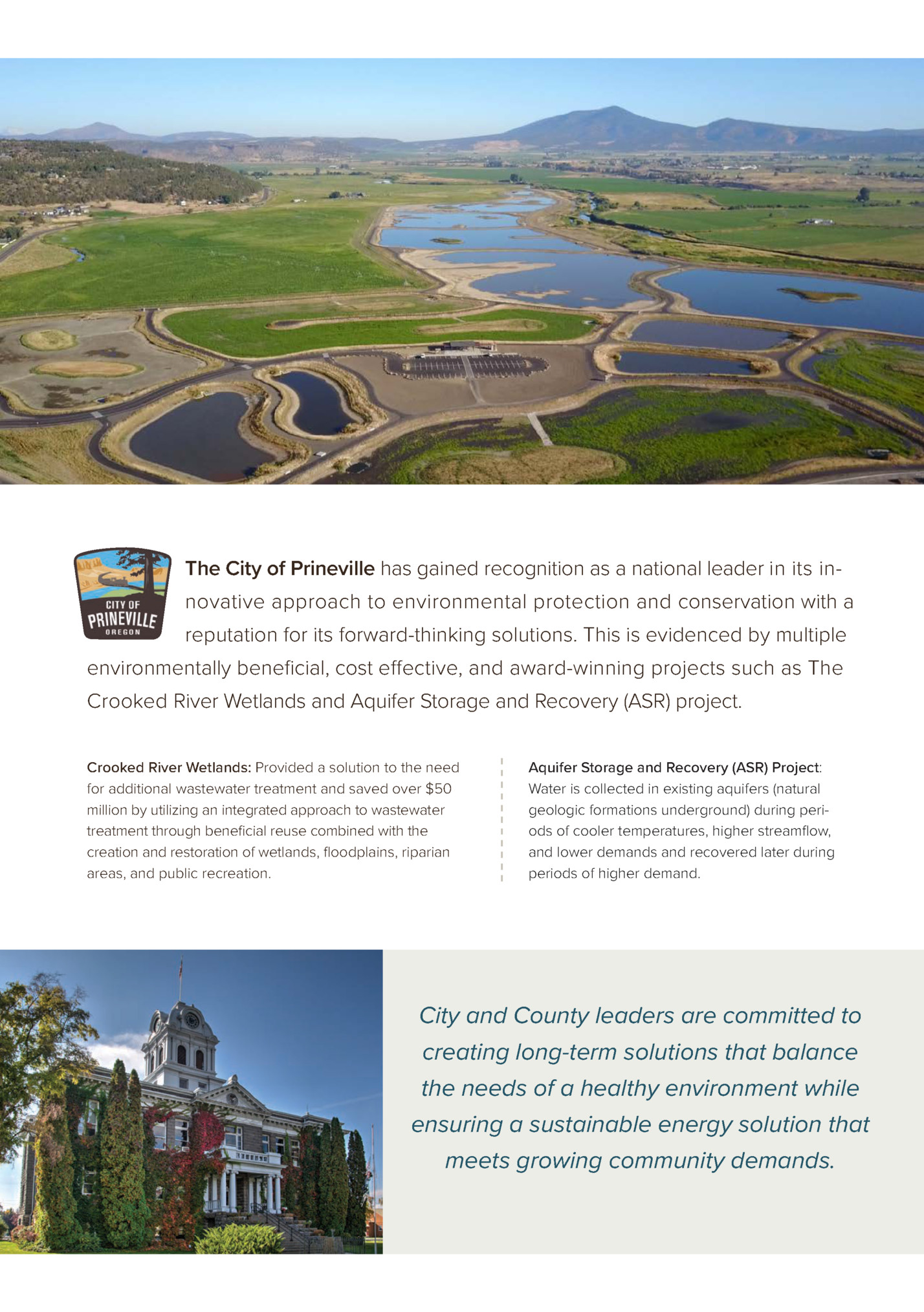
The City of Prineville and Crook County have plans to build and operate a 24.9-megawatt biomass power plant facility. A sustainable and stable fuel supply is a common barrier to the development of woody biomass power projects. To overcome this barrier, the PREP has secured a private wood fuel supply comprised of urban wood waste, forest derived fuel, and agricultural waste to fire the plant for 20 years, but with flexibility to utilize other fuel streams as they are available. While this private supply is necessary to ensure fuel supply and price stability, the focus of the PREP is on forest health improvement with a goal of utilizing residuals and wood waste from forested lands to the highest extent possible. The PREP will create an opportunity for the treatment/restoration of up to up to 2.5 acres per hour. Before (left) and after (right) treatments by thinning and burning in ponderosa pine. By almost all measures, the treated plot is ecologically healthier and more resilient to fire. The photos are not of the identical scene but representative examples from the same site. Forest restoration, thinning and fuel hazard reduction activities, which generate biomass for energy use, create more resilient forest stand conditions. These actions can reduce the amount and severity of wildfires, damages to life, property and natural resources, air quality and public health impacts from wildfire smoke, and fire suppression costs. They also encourage more rapid growth on the remaining trees, resulting in bigger and more robust trees. Advantages of Biomass Energy 1 2 SHANE JEFFRIES Ochoco National Forest Supervisor 3 Contributions to rural economies: 4 FOREST HEALTH & WILDFIRE PROTECTION: ABUNDANT: CLIMATE CHANGE MITIGATION: “This win-win project will provide us greater opportunities to manage areas to improve forest health and restore wildlife habitat by creating local market opportunities for small diameter trees and low-value species such as western juniper.” Biomass is available in large quantities all over the world. Use of biomass energy in lieu of fossil fuels reduces greenhouse gases. Biomass utilization also provides a disposal alternative to open burning and landfills for forest treatment wood wastes. PREP’s local fuel supply will also reduce greenhouse gas emissions and usage of fossil fuels compared to traditional fuel supply resource areas. Diesel consumption per bone dry ton isexpected to be cut in half. Biomass utilization can create jobs in rural economies that were once dependent on traditional resource-based industries. These include natural resources and forestry jobs. Forest restoration, thinning and fuel hazard reduction activities, which generate biomass for energy use, create more resilient forest stand conditions. These actions can reduce the amount and severity of wildfires, damages to life, property and natural resources, air quality and public health impacts from wildfire smoke, and fire suppression costs. They also encourage more rapid growth on the remaining trees, resulting in bigger and more robust trees.
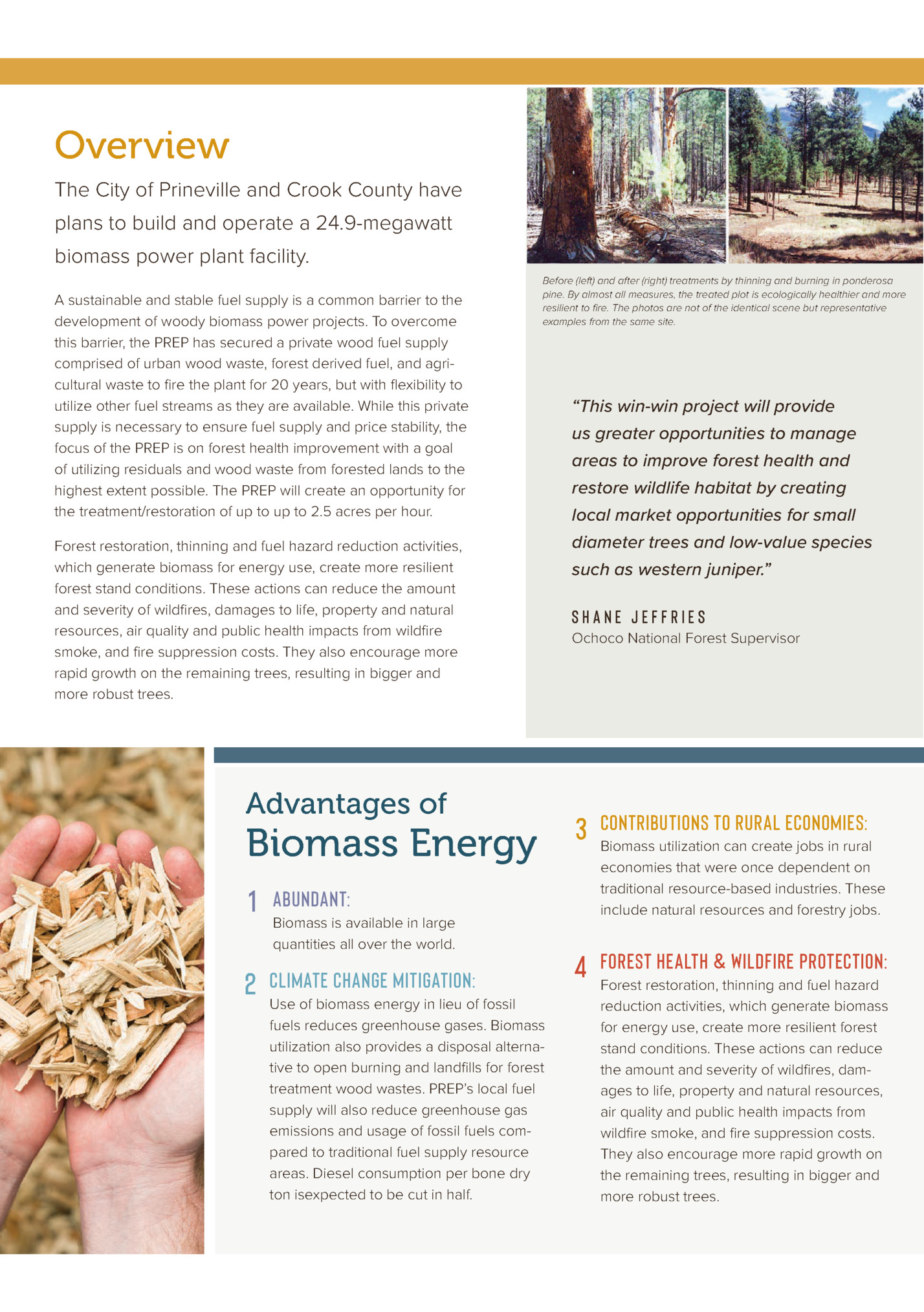
Preparing for the Inevitable The USDA Forest Service is progressing from a land management strategy built on timber extraction towards one oriented around maintaining healthy forested lands. The Healthy Forest Initiative promotes the idea of broadscale forest thinning and fuel treatments as an effective means for mitigating hazardous fuel conditions and, by extension, fire risk. Fuels mitigation is proactive, while fire suppression is reactive and expensive. Elevating the Community: • Resurrecting Prineville’s forest products industry • Local baseload generating asset, 24/7 operation The City and County are committed to working • Regional economic impact with a broad range of stakeholders to restore • Sustainable management of the Ochoco Forest healthy forest conditions while creating a • Innovative forest products hub of Central Oregon reliable and renewable source of energy. 5 6 Habitat protection: When conducted appropriately, biomass harvesting has a negligible impact on wildlife and watersheds, improves the growth of larger trees, and can protect habitats by enhancing the resilience of forest stands and individual trees. Renewable green energy: Biomass power is renewable energy and reduces reliance on fossil fuels. Forests store substantial amounts of carbon. Forests generally go through cycles of growth and death, sequestering and releasing carbon. The value of forests and trees in sequestering carbon and reducing carbon dioxide emission to the atmosphere is being recognized increasingly the world over. Well-directed carbon sequestration projects, along with the provision of sustainably produced timber, fiber, and energy, will yield numerous benefits, including additional income for rural development and prospects for conservation. Next Step: A Public Private Partnership The City of Prineville is seeking customers to purchase renewable attributes created by the PREP and legislative action that supports market electric rates/schedules that accurately value those biomass baseload, renewable attributes. PHASE 1 Feasibility and Design PHASE 2 Launch and Permitting PHASE 3 Construction
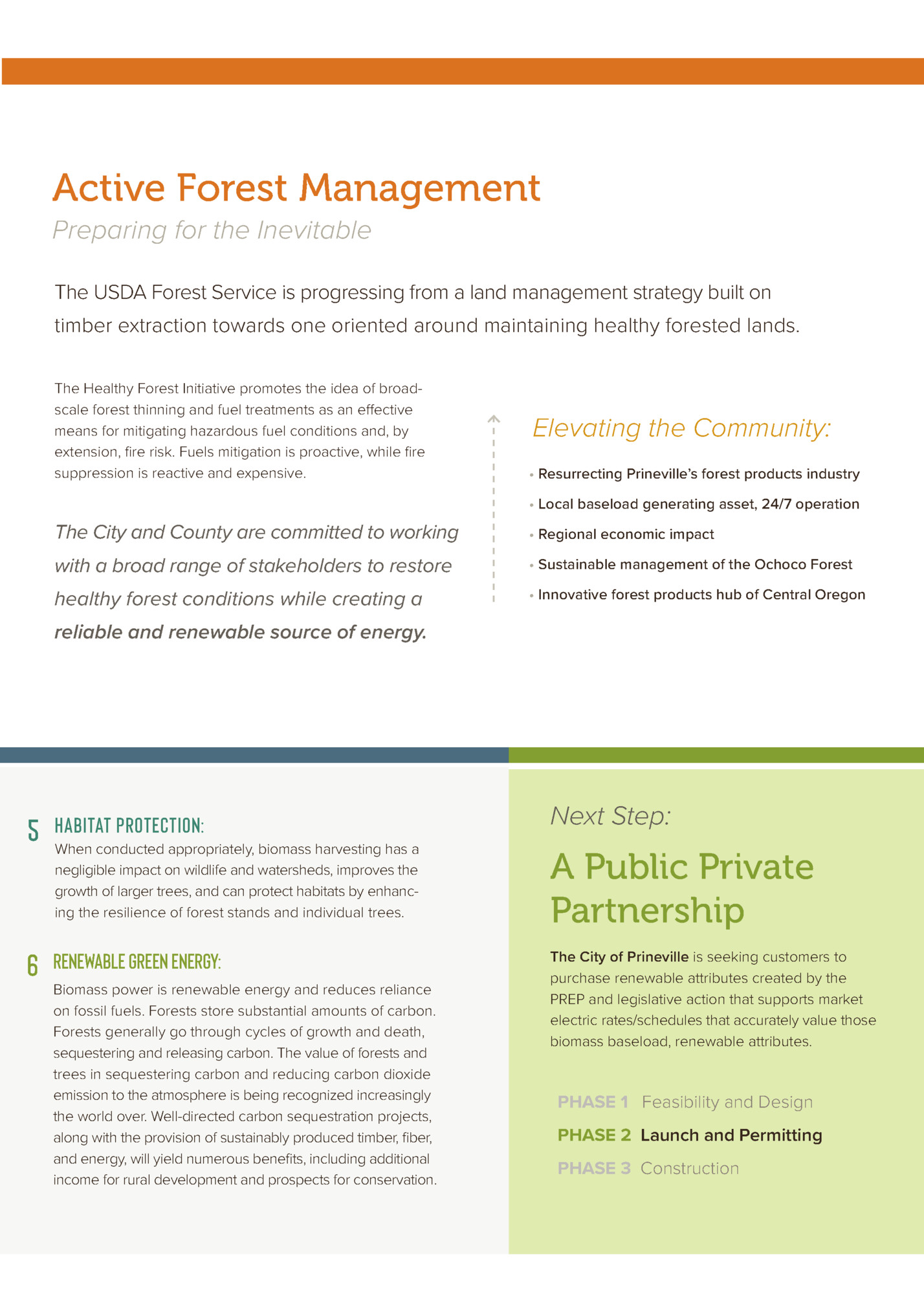
on Air Quality Biomass plants generate clean energy due to advanced technologies that “scrub” the air of particulate matter and other contaminants. Particulate matter is the principal health concern associated with the public’s exposure to wildfire smoke and is reduced by over 99% with these technologies when compared to open burning⁴. 50 0 30 Oregon’s 2020 fire season demonstrated just how at risk 150 20 our forests are to catastrophic 0 0 10 wildfire and how the smoke from these fires presents a serious public health hazard. Beyond Index The fine particles in the smoke, known as PM 2.5, pose the Current Air Quality 9AM PDT Sep 11 greatest risk. The EPA’s air qual594 NowCast AQI PM2.5 ity index, which measures PM 2.5, categorizes the air quality on Today Tomorrow More Forecast AQI a scale from good to hazardous. Unhealthy Not In September of 2020, the air for Sensitive Available Groups quality in Central Oregon was so hazardous it was beyond the top threshold of the index. Those most at risk to effects from poor air quality include children, pregnant women, older adults, and individuals with heart or lung disease, or diabetes⁵. Use of biomass in lieu of fossil fuels reduces greenhouse gases and provides a disposal alternative to open burning and landfills for forest treatment wood wastes. Woody biomass offers a sustainable, dependable supply that typically emits 90% less CO2 compared to fossil fuels⁶. Regenerating forests can also result in net carbon sequestration (which is the process by which atmospheric carbon dioxide is taken up by trees, grasses, and other plants) in wood products and new forest growth¹. Exposure to open burning is associated with reduced lung function, bronchitis, exacerbation of asthma and heart failure, and premature death. Fine particles are also the main cause of reduced visibility in parts of the US, including many of our treasured national parks and wilderness areas⁹. Other contaminants such as carbon monoxide and nitrogen oxides are reduced by approximately 99% and 70%, respectively, when compared to open burning¹⁰.
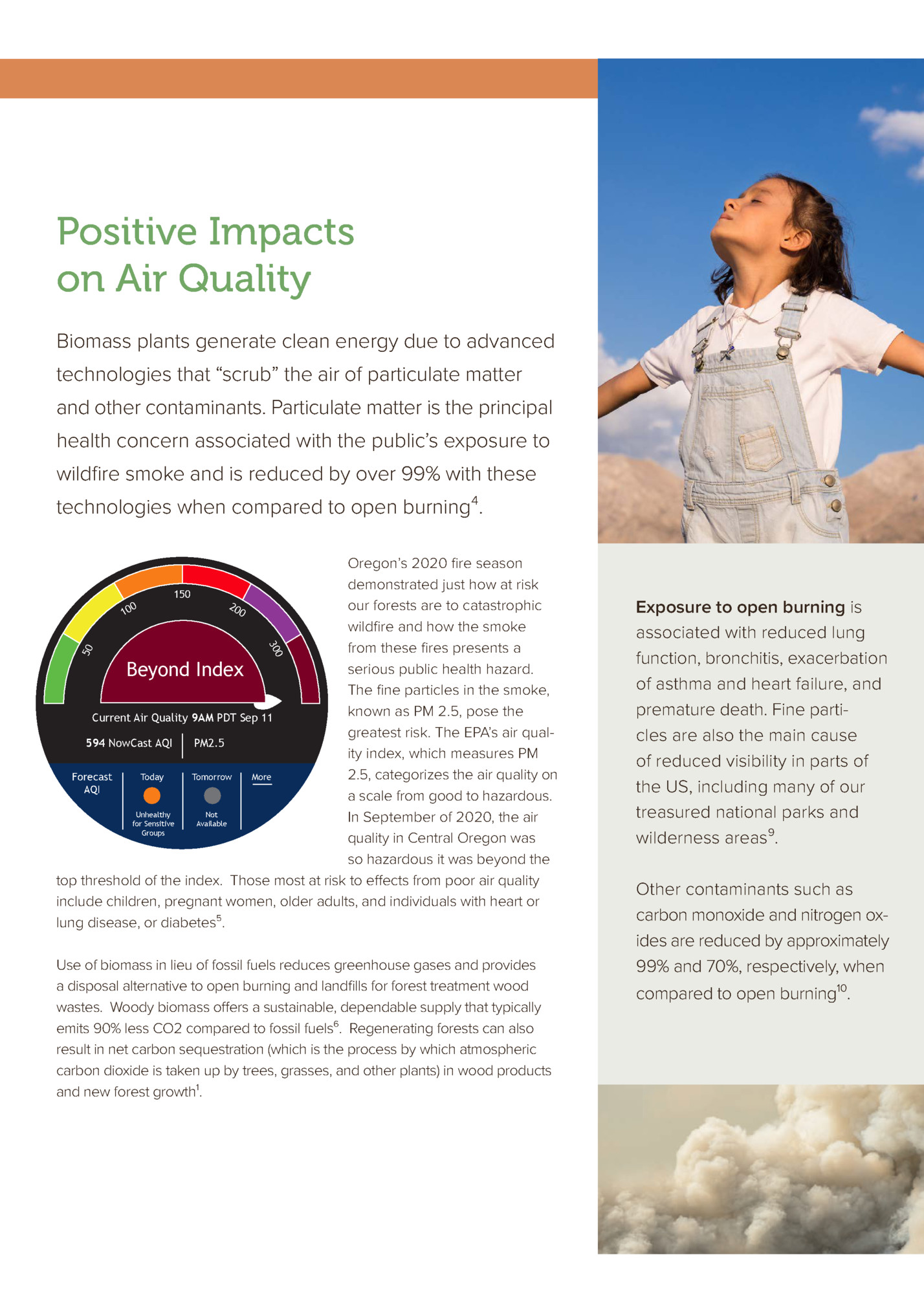
Quality and Quantity The Prineville Rewewable Energy Project would provide significant benefit to watersheds by improving the quantity of water available and enhancing ecosystems with improved soil and water quality¹. An extensive, long-term study in the Prineville area confirmed that removal of juniper and subsequent reestablishment of historical native shrub/grass plant community improved soil and water infiltration, reduced overland flow and soil loss making more water available for plant growth, groundwater recharge, and sustained spring flow². These improvements would be made by employing sustainable forestry practices, such as forest restoration and removal of western juniper. This would also help to protect key watersheds from catastrophic damage, which ensures that sustainable quantities of high quality water for both domestic and agricultural uses continues to flow. Since the 1880s, juniper range has increased tenfold in the Central Oregon area due to reduction in fire. Pre-European settlement, juniper was limited primarily to areas that did not support fire on relatively unproductive soils. The species elbows out native sagebrush and grasses and sucks up more than its fair share of water. Research has shown that juniper abatement results in estimated water savings of 100,000 gallons per acre annually.⁷ Works Cited “Biomass and Bioenergy.” CA.gov, 10 June, 2019, https://www.energy.ca.gov/data-reports/california-power-generation-and-power-sources/biomass “Local Renewable Energy Benefits and Resources.” United States Environmental Protection Agency, 11 June, 2019, https://www.epa.gov/statelocalenergy/local-renewable-energy-benefits-and-resources Stone, Carter; Hudak, Andrew T.; and Morgan, Penelope, “Forest Harvest Can Increase Subsequent Forest Fire Severity” (2004). USDA Forest Service / UNL Faculty Publications. 199. http://digitalcommons.unl.edu/usdafsfacpub/199 ¹ “Carbon Sequestration.” United States Forest Service, 17 September, 2019, https://www.fs.fed.us/ecosystemservices/carbon.shtml ² “Increasing Water Availability Through Juniper Control.” Oregon.gov, 17 September, 2019, https://digital.osl.state.or.us/islandora/object/osl:758004/datastream/OBJ/view ³ “Taking the pulse of water in western juniper woodlands.” Oregon State University, 20 October, 2019, http://oregonprogress.oregonstate.edu/winter-2017/taking-pulse-water-western-juniper-woodlands ⁴“1.6 Wood Waste Combustion.” United States Environmental Protection Agency, 16 October, 2019, https://www3.epa.gov/ttn/chief/old/ap42/ch01/s06/final/c01s06_feb1999.pdf ⁵ “13.1 Wildfires and Prescribed Burning.” United States Environmental Protection Agency, 19 October, 2019, https://www3.epa.gov/ttnchie1/ap42/ch13/final/c13s01.pdf ⁶ “Techline, Wood Biomass for Energy.” Forest Products Laboratory, 17 September, 2019, https://www.fpl.fs.fed.us/documnts/techline/wood-biomass-for-energy.pdf ⁷ Bedell, T.E.; Eddleman, L.E.; Deboodt, T.; Jacks, C., “Western Juniper-Its Impact and Management in Oregon Rangelands.” (1993). Oregon State University Extension Service. 5. https://juniper.oregonstate.edu/sites/default/files/bibliography/documents/phpAgzGdM_EC1417.pdf ⁸ “Greenhouse Gases Equivalencies Calculator – Calculations and References.” United States Environmental Protection Agency, 19 October, https://www.epa.gov/energy/greenhouse-gases-equivalencies-calculator-calculations-and-references ⁹ “Wildfire Smoke A Guide for Public Health Officials.” United States Environmental Protection Agency, 16 October, 2019, https://www3.epa.gov/airnow/wildfire_may2016.pdf ¹⁰ “Biomass Provides Air Quality Benefits.” California Biomass Energy Alliance, 16 October, 2019, http://www.calbiomass.org/air-quality/ ¹¹ “The Value of the Benefits of U.S. Biomass Power.” Nrel.gov, 18 September, 2020, https://www.nrel.gov/docs/fy00osti/27541.pdf

prineville remembers 2019 marked the 25th anniversary of the deaths of the 14 firefighters. A 1994 wildfire seven miles west of the resort town of Glenwood Springs in central Colorado changed Prineville, Oregon forever. The South Canyon fire on Storm King Mountain became one of the worst wildland firefighting disasters in 45 years. Fourteen people died, including nine members of the Prineville Hotshot crew. South Canyon fire sparked scrutiny of fire officials’ decision-making and strategies in battling deadly fires and forest management practices. Significant changes in land management over the past several decades has resulted in catastrophic wildfires. Declines in timber production on federal lands, particularly in the Northwest, not only meant the death of a once vibrant industry, but also an end to thinning, controlled burns and other activities meant to keep forest growth in check. Prineville has experienced firsthand how allowing forests to grow unchecked by proper management results in catastrophic wildfires. Department of Public Works ENGINEER ING D EPARTMENT (541) 447-2357 (541) 447-5628 E M AI L eklann@cityofprineville.com PHO N E FA X
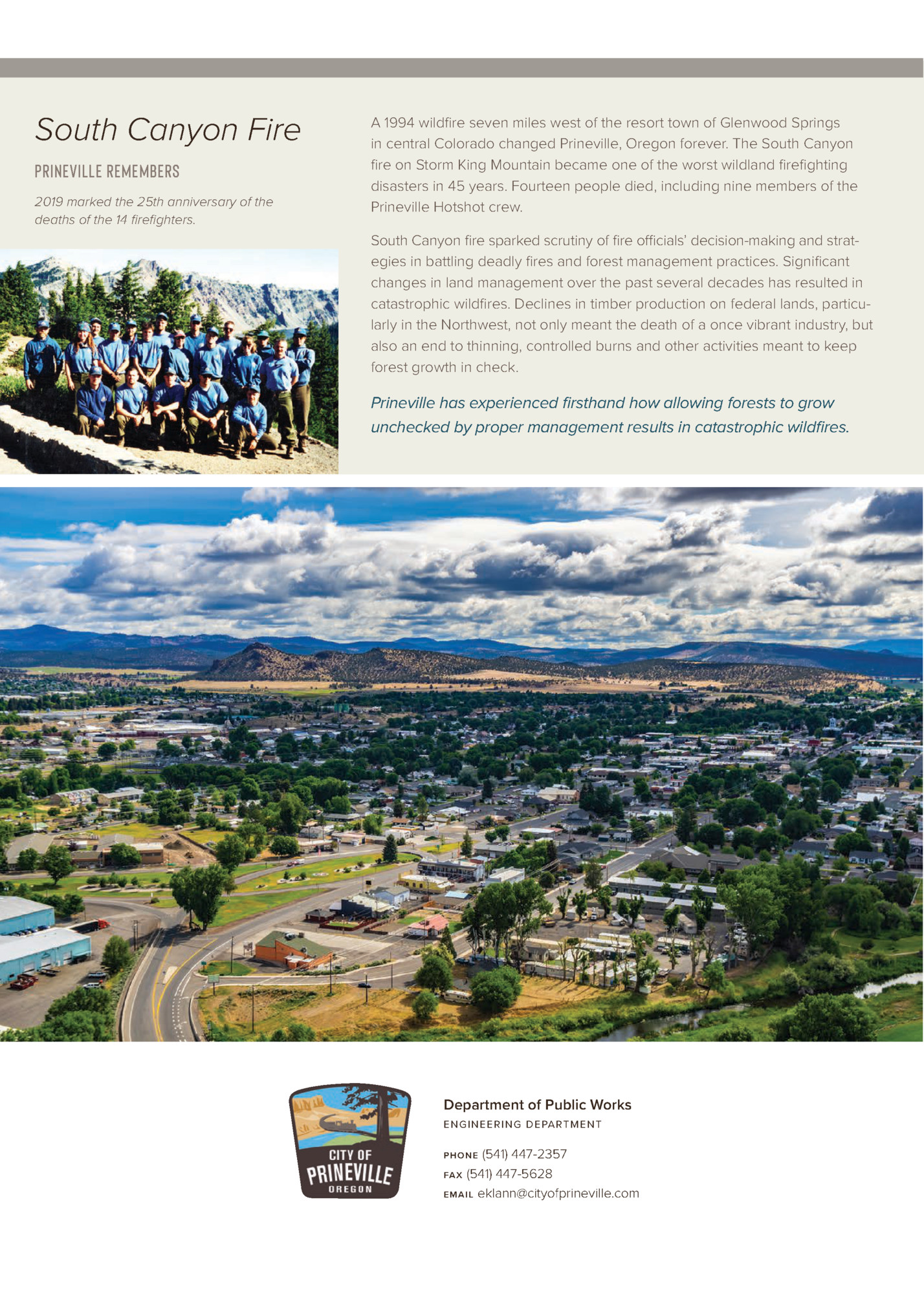
Fleepit Digital © 2021